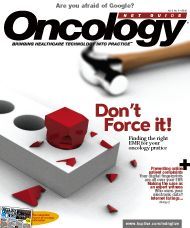Publication
Article
ONCNG Oncology
Oncology Outlook: Breast Cancer Care: A Focused Factory with an Evolving Architecture
Author(s):
The evolution of the clinical care of breast cancer patients has been a leading model for clinical cancer research and the management of other solid tumors.
The evolution of the clinical care of breast cancer patients has been a leading model for clinical cancer research and the management of other solid tumors. As we start on the path of defining the optimal IT architecture for the care of our cancer patients, breast cancer serves as an excellent model in community cancer care. The journey of each breast cancer patient is unique and complex. For most patients, the path begins with the initial screening imaging studies (mammography or MRI) followed by biopsies, surgery, adjuvant radiation, and chemotherapy.
Many elements of this journey are common to many types of cancer patients. However, in a manufacturing model, if the whole cancer service line is a factory, then breast cancer represents a factory within a factory—a focused factory, if you will, that provides the unique services needed by breast cancer patients.
The term “focused factory” was introduced in a 1974 Harvard Business Review article authored by Wickham Skinner in the midst of a productivity crisis. The model proposed focusing each plant on a limited set of products and technologies. As summarized by R. Anthony Inman, a factory focused on a specifi c product can outperform a conventional plant with a broader focus. All the equipment, supporting systems, and procedures can concentrate on a limited set of tasks for one set of customers. The focused factory concept has been applied to healthcare. Specialty hospitals and ambulatory surgery centers (ASC) are examples of the success of focused factories. These facilities are not organized by medical specialty but for the total needs of the patient. How do we apply these principles to the care of our patients?
How do we build IT systems that are based on an architecture that can support our goals?
In the last two columns, I discussed the importance of focusing on value for the customer (best outcomes for the lowest cost) and a great service experience. If one looks at the breast cancer patient’s journey, the volume of information and images that need to be shared and discussed is enormous. Today, IT systems are clearly the key enabler. The barriers are costs and knowledge of IT systems and their implementation. Improvements in efficiencies and quality of care can be gained with better communications and reductions in variation. However, the central enabler is the IT platform that supports this functionality. What does it look like? What are the components? What pieces are currently available? How do we build it?
Currently, your organization has an IT architecture, even if it is completely paper- and fax-based. A great place to begin IT adoption is to take a snap shot of the current architecture and then go through the process of developing an executive direction for what things need to look like in the future.
Drivers for executive direction can vary for diff erent organizations and in diff erent markets. These need to be carefully thought out. Universal drivers for the care of cancer patients and for breast cancer patients in particular include:
- Optimizing outcomes
- Maximizing safety and reducing errors
- Optimizing financial performance
- Maximizing customer service
- Tracking and reducing variation
- Articulating value provided
- Improving current processes
- Transforming processes
- Personalizing care
- Assimilating decision support tools and algorithms at the point of care
- Maximizing contributions to research
- Developing a clinical data repository of mineable data
Going through the architecture planning process forces one to ask certain questions. This prospective planning of what is to be built enhances the likelihood of success while minimizing the risks of poor planning with resultant strategic disasters. Once there is a snapshot of a future architecture, only then can a migration plan with budgets be constructed.
Even once the architecture is built, the process continues into an assessment phase of how well the architecture works. What are its dependencies and vulnerabilities? How would recovery occur in the event of a disaster? How are future technologies that are still far on the horizon going to be assimilated? IT architectures are not the business. IT systems are the key tool that support the goals of ideal care.
In the next couple of columns, I will look at the breast cancer patient’s journey as the factory that needs to be supported.
Jivesh Sharma, MD, is CEO of Texas Cancer Associates, a midsize oncology practice based in Dallas/Fort Worth, TX. He is also CEO of HealthIT, an Internet services company that supports the patient/ provider network with technology solutions, and founder of NextGen Oncology, which works to provide next-generation solutions for the diagnosis, management, and treatment of cancer. E-mail Dr. Sharma at JSharma@MyCancerCenter.com.
